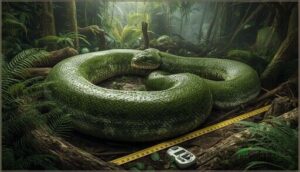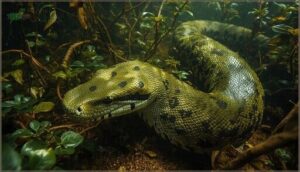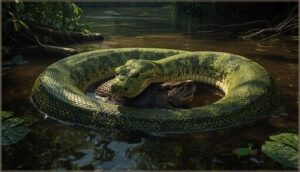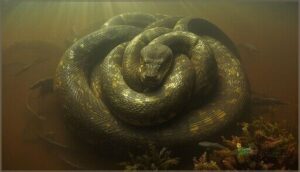This site is supported by our readers. We may earn a commission, at no cost to you, if you purchase through links.

You’ve probably heard stories about anacondas that blur the line between reality and myth. These South American constrictors aren’t the man-eating monsters Hollywood portrays, but the truth is just as extraordinary.
Green anacondas claim the title of world’s heaviest snake, with females tipping the scales at over 200 pounds and stretching beyond 20 feet. Their smaller cousins—yellow, dark-spotted, and Beni anacondas—each carve out their own territories across the continent’s wetlands.
Understanding these powerful predators means separating fact from fiction, from their aquatic hunting strategies to their surprising reproductive behaviors that challenge what you might expect from a reptile.
Table Of Contents
- Key Takeaways
- Anaconda Species and Classification
- Anaconda Size and Physical Features
- Habitat and Geographic Range
- Diet and Hunting Behavior
- Reproduction and Lifespan
- Frequently Asked Questions (FAQs)
- What are three interesting things about an anaconda?
- What are the special things about Anaconda?
- What are some cool facts about anacondas?
- What are 5 facts about anacondas?
- What is special about anaconda?
- How fast can anacondas move?
- How big can anaconda swallow?
- How fast is an anaconda?
- What does an anaconda eat?
- How long do anacondas live?
- Conclusion
Key Takeaways
- Green anacondas hold the title of the world’s heaviest snake, with females reaching over 200 pounds and 20 feet in length, while three smaller species—yellow, dark-spotted, and Beni anacondas—occupy distinct South American territories.
- These constrictors kill through powerful constriction rather than venom, using ambush tactics from aquatic hiding spots to capture prey as large as deer and caimans, which they swallow whole thanks to jaw flexibility that stretches up to four times their head diameter.
- Female anacondas dwarf males dramatically (70 pounds versus 15 pounds), giving birth to 20-40 live young after intense “breeding ball” competitions where up to 13 males wrestle for mating rights.
- Anacondas thrive in South American swamps and flooded forests with specialized adaptations including eyes and nostrils positioned on top of their heads for breathing while submerged, heat-sensing pits for detecting warm-blooded prey, and the ability to fast for over five months while digesting massive meals.
Anaconda Species and Classification
You might picture one giant snake when you think of anacondas, but there’s actually more to the story. Scientists recognize several distinct species within the genus Eunectes, each with its own size range and geographic home.
Let’s break down these fascinating constrictors and see where they fit in the reptile family tree.
Green Anaconda (Eunectes Murinus)
The green anaconda, Eunectes murinus, reigns as the world’s heaviest snake and a dominant predator of South American waterways. You’ll find this reptile thriving in the Amazon and Orinoco basins, where its olive-green skin and dark blotches create perfect aquatic camouflage. They’re also known to thrive in dense tropical environments.
Key Green Anaconda Characteristics:
- Maximum size: Females reach 4.6 meters; some exceed 9 meters
- Sexual dimorphism: Females outweigh males considerably
- Anaconda diet and behavior: Ambush hunters targeting capybaras, caimans, deer
- Reproduction rates: Birth 20–40 live young after seven-month gestation
- Anaconda size and growth: Rapid early development; mature at 3–4 years
Yellow Anaconda (Eunectes Notaeus)
While the massive Eunectes murinus draws attention, its smaller cousin deserves yours too. The yellow anaconda (Eunectes notaeus) usually reaches 3 to 4.6 meters, with females outweighing males considerably.
You’ll spot these snakes by their golden-tan base marked with dark saddles—perfect camouflage in Paraguay’s swamps and Argentina’s wetlands, where they employ patient ambush hunting strategies against fish and small mammals. These snakes are also excellent swimmers and can hold their breath for up to 10 minutes.
Dark-spotted and Beni Anacondas
Two lesser-known species round out the anaconda lineup: the dark-spotted anaconda (Eunectes deschauenseei) and the Beni anaconda (Eunectes beniensis).
You’ll find dark-spotted anacondas in northern Brazil’s flooded savannas, where habitat threats from agriculture loom. Limited data on Beni anaconda distribution—restricted to Bolivia’s Beni region—makes conservation status uncertain.
Size variations, genetic differences, and diet specifics remain understudied for both.
Relation to Boidae Family
All four anaconda species belong to the Boidae family, sharing evolutionary history with boas across the Americas. You’ll recognize Boidae characteristics like viviparous traits—they give birth to live young—and chromosomal diversity that tells a story of adaptation.
The scientific name Eunectes reflects their classification within this ancient lineage, shaped by biogeographical factors in South America’s isolated ecosystems where anacondas evolved their unique aquatic lifestyle.
Reptile and Constrictor Classification
As reptiles, you’ll find anacondas classified under Squamata, the order encompassing all snakes and lizards. Their taxonomy places them firmly among constrictors—snake constrictors that kill without venom.
The Eunectes genus evolved distinct traits within Boidae evolution, including heat-sensing pits and vestigial hind limbs. These constrictor traits set anacondas apart from venomous species, relying instead on powerful muscular coils for survival.
Anaconda Size and Physical Features
When you think of anacondas, size is probably the first thing that comes to mind. These snakes don’t just look impressive—they’re among the largest reptiles on Earth, with bodies built for power and survival.
Let’s look at what makes their physical features so striking.
Record-Breaking Length and Weight
You might think anacondas grow to monstrous lengths, but specimen verification tells a different story. The longest confirmed green anaconda measured 8.43 meters, while the heaviest weighed about 227 kilograms.
Size misconceptions often arise from measurement challenges in the wild, where scaling factors and growth anomalies make accurate data scarce.
Anaconda size and weight depend heavily on prey availability and habitat quality.
Skin Patterns and Camouflage
Beyond their size, you’ll notice anacondas wear elaborate skin patterns that serve as nature’s invisibility cloak. Green anacondas display olive backgrounds with oval black spots, while yellow anacondas show overlapping dark markings on yellowish skin. Pattern camouflage functionality works through disruptive coloration that breaks up their outline underwater. Geographic skin variation and developmental pattern changes mean juveniles have bolder patterns that fade with age, reflecting evolutionary skin basis rooted in survival advantage.
- Head stripes aid species identification in murky water
- Contrasting spots blend with shadowed vegetation
- Texture reduces glare for stealthy ambush hunting behavior
- Localized adaptations match specific habitat conditions
Jaw Structure and Feeding Adaptations
When you consider how anacondas swallow prey as large as deer, jaw flexibility becomes essential. Their jaws connect with stretchy ligaments rather than rigid bone, allowing both sides to spread wide and “walk” forward independently.
Six rows of backward-pointing teeth grip victims during constriction, while a specialized windpipe lets them breathe throughout the swallowing process—an extraordinary feeding mechanism shaped by millions of years.
Sexual Dimorphism
Female anacondas dwarf males in one of nature’s most dramatic size differences—females average 70 pounds, while males weigh just 15 pounds. This sexual dimorphism drives the entire mating system you’ll find in anacondas:
- Female Size Advantage: Larger bodies support greater reproductive investment, producing up to 40 live young per breeding cycle
- Male Competition: During breeding balls, up to 13 males compete for one female
- Species Comparison: Green anacondas show the most extreme dimorphism among all anaconda species characteristics
Habitat and Geographic Range
You’ll find anacondas in the warm, wet corners of South America, where water and land meet in a tangle of rivers and swamps. These snakes aren’t just scattered randomly across the continent—each species has carved out its own territory, shaped by the waterways and flooded forests they call home.
Let’s look at where these massive constrictors live and how their ranges differ across the region.
Native Regions in South America
You’ll find anacondas thriving across South America’s biodiversity hotspots, where tropical rainforests meet sprawling freshwater ecosystems. Geographic isolation has shaped distinct populations, with each anaconda species claiming its own corner of this vast habitat.
The green anaconda dominates the Amazon and Orinoco basins, stretching through Brazil, Venezuela, Colombia, and Peru. Yellow anacondas prefer Paraguay’s marshlands and Argentina’s wetlands, while dark-spotted species inhabit northern Brazil’s South American swamps.
Preferred Aquatic Environments
Within these South American ranges, you’ll discover anacondas gravitating toward specific aquatic environments. These semiaquatic snakes thrive where water meets their hunting needs:
- Shallow, slow-moving streams and river basins with minimal current
- Swamps and wetlands rich in aquatic plants for camouflage
- Flooded forests during seasonal inundation
- Marshes with warm freshwater and abundant prey
Swamp ecosystems provide ideal cover for their ambush tactics, supporting their aquatic life year-round.
Adaptations to Swampy and Flooded Habitats
Living in swamps and flooded wetlands has shaped the anaconda’s entire biology. Their eyes and nostrils sit on top of their heads, a perfect adaptation for breathing while submerged. These semiaquatic snakes utilize aquatic sensing through heat-detecting pits along their mouths, enabling them to track warm-blooded prey even in murky marshes. Their camouflage strategies blend seamlessly with submerged vegetation, and their flooded refuge offers protection from land predators.
Adaptation Type | Function | Habitat Benefit
— | — | —
Submersion Tactics | Hold breath 10 minutes | Extended underwater hunting
Thermal Regulation | Bask near waterbanks | Temperature control in wetlands
Body Structure | Sleek, muscular | Efficient swamp navigation
Range Differences Among Species
Each anaconda species claims its own slice of South America. Green anacondas dominate the Amazon and Orinoco basins, stretching from sea level to 1,000 meters elevation. Yellow anacondas prefer southern wetlands in Paraguay and Bolivia. The Beni anaconda stays close to Bolivia’s flooded plains, while dark-spotted anacondas occupy northern Brazil’s coastal regions.
Geographic barriers like the Andes and habitat fragmentation keep these populations largely separate, making species isolation a natural pattern. Conservation efforts now protect these distinct range dynamics across their native territories.
Diet and Hunting Behavior
Anacondas are dominant predators with a carnivorous appetite that matches their impressive size. These powerful constrictors use stealth and strength to capture prey ranging from fish and birds to wild pigs and even jaguars.
Let’s examine how these snakes hunt, what they eat, and the striking feeding process that allows them to consume animals much larger than their own heads.
Common Prey and Carnivorous Diet
As obligate carnivores, anacondas exhibit impressive dietary adaptability, consuming a wide variety of prey. Their hunting behavior is opportunistic, targeting whatever prey they can overpower.
The anaconda diet reflects striking prey diversity across their habitats:
- Birds and mammals dominate the anaconda diet and prey, especially aquatic birds and capybaras
- Reptiles like caimans and turtles provide substantial meals
- Fish appear less frequently than expected despite their aquatic hunting strategies
Anaconda hunting behavior changes with whatever prey they can overpower.
Ambush Predation and Constriction
You’ll find anacondas waiting motionless for days, perfecting their ambush tactics as some of nature’s most patient predators. When prey wanders within striking distance, they attack with 60–70% hunting success in ideal conditions.
Their constriction pressure exceeds 90 mmHg, triggering circulatory arrest within seconds. This anaconda hunting behavior reflects millions of years refining predator-prey relationships through powerful ambush predation strategies.
Swallowing Prey Whole
Once the prey stops moving, you’ll witness one of nature’s most extraordinary feats—an anaconda’s jaw mechanics allow its mouth to stretch up to four times its head diameter. Highly elastic ligaments and independently moving lower jaws enable prey ingestion of animals nearly matching the snake’s own weight.
An anaconda’s jaw can stretch four times wider than its head to swallow prey nearly its own weight
The windpipe extends forward during the swallowing process, letting the snake breathe while maneuvering meals down its digestive system.
Feeding Frequency and Digestion
After swallowing massive meals, you’d be amazed to learn anacondas can fast for over five months while digesting their prey. Digestion speed depends on prey size and ambient temperature, with larger animals requiring several weeks to fully break down. Metabolic rate spikes dramatically during this process, then drops to conserve energy between feedings.
Feeding patterns reveal nature’s efficiency:
- Adult females hunt more frequently than males due to reproductive energy demands
- Maximum prey size increases with snake body length, affecting digestion duration
- Digestive tissues actually shut down between meals, regenerating only when new prey arrives
Reproduction and Lifespan
Anacondas have a fascinating reproductive cycle that sets them apart from many other snakes. During the breeding season, you’ll find multiple males competing for a single female in what scientists call a “breeding ball.”
Understanding how these massive constrictors reproduce, care for their young, and grow over time gives you a clearer picture of their extraordinary life cycle.
Mating Behaviors and Breeding Balls
When you observe anaconda reproductive habits during mating season, you’ll witness a remarkable spectacle called breeding ball formation. Courtship rituals begin when breeding females emit pheromones to attract males.
Male competition intensifies as 2 to 13 males coil around a single female in these mating balls, wrestling for dominance for up to four weeks. Female selection ultimately determines which male succeeds in this intense breeding behavior in anacondas.
Live Birth and Offspring Numbers
Unlike most reptiles, anacondas are ovoviviparous—females don’t lay eggs but give birth to fully formed live young. Here’s what you should know about anaconda reproduction and life cycle:
- Green anaconda species usually deliver 20 to 40 neonates per litter, though rare cases reach 100 offspring
- Yellow anaconda litter size ranges from 4 to 82 young
- Birth frequency occurs every other year for green anacondas due to energy demands
- Maternal care is absent—newborns immediately fend for themselves, facing high mortality rates
Neonate survival depends entirely on offspring development before birth.
Growth and Sexual Maturity
Baby anacondas start at just 2 feet long, but you’ll witness striking growth patterns as they mature. Anacondas grow rapidly during their first years, reaching sexual maturity between 3 and 6 years of age. Development stages show a notable 500-fold increase in biomass from birth to adulthood.
| Growth Factor | Female | Male |
|---|---|---|
| Maturity Age | 3-6 years | 3-6 years |
| Adult Length | 15.5 feet avg | 9 feet avg |
| Adult Weight | 70-150 lbs | 35-75 lbs |
| Time to Maturity | ~912 days | Slightly earlier |
Maturation rates depend heavily on prey availability and environmental conditions. Sexual dimorphism in anacondas becomes evident as females grow substantially larger than males. Anaconda reproduction and life cycle timing varies between anaconda species, with captive individuals often maturing faster due to consistent food access.
Lifespan in Wild and Captivity
Once anacondas reach maturity, their lifespan depends heavily on their environment. In the wild, survival averages just 10 years due to environmental impact, predation, and mortality rates from harsh conditions.
Captive care changes everything—you’ll find anacondas in captivity thriving for 30 years or more, with proper nutrition and veterinary attention. The oldest recorded green anaconda lived an impressive 37 years, showing how aging factors shift dramatically between settings.
Frequently Asked Questions (FAQs)
What are three interesting things about an anaconda?
You won’t believe their size—green anacondas can reach 20 feet and weigh over 200 pounds.
They’re ambush hunters using constriction, not venom.
Females give birth to up to 40 live young at once.
What are the special things about Anaconda?
Your understanding of anaconda characteristics starts with their formidable strength and constriction power. These exceptional predators use water adaptation and snake camouflage as survival strategies, employing ambush predator tactics that make them top hunters in their habitats.
What are some cool facts about anacondas?
You might be surprised to learn that anacondas can reproduce without males through parthenogenesis—an extraordinary snake fact.
These reptiles also exhibit surprising intelligence in hunting tropical ecosystems, embodying both wild encounters and conservation concerns.
What are 5 facts about anacondas?
You’ll find that green anacondas grow up to 20 feet long and weigh over 200 pounds, making them the world’s heaviest snake. Their remarkable muscular strength allows them to constrict prey underwater.
What is special about anaconda?
You’ll find anacondas are special because they blend impressive size with aquatic adaptations.
Eyes and nostrils positioned for submerged hunting, powerful constrictor techniques, and camouflage make these top predators nearly invisible in tropical habitats.
How fast can anacondas move?
You’ll find anacondas move surprisingly slow on land, reaching only about 5 mph, but their swimming abilities shine in water where they glide up to 10 mph using powerful aquatic adaptations.
How big can anaconda swallow?
You’d be amazed—anacondas can swallow prey up to 50% of their own body mass. Their stretchy jaws and elastic bodies let them consume capybaras, caimans, and even deer whole.
How fast is an anaconda?
Like a submarine gliding through murky depths, an anaconda reaches swimming speeds up to 10 mph in water.
On land, you’ll see it crawl much slower at around 5 mph, relying on ambush tactics rather than pursuit.
What does an anaconda eat?
You’ll find anacondas dining on large fish, rodents, caimans, wild pigs, and deer.
Their prey selection depends on availability and size, with hunting tactics involving patient ambush and powerful constriction to subdue their meals.
How long do anacondas live?
In the wild, you’ll find anacondas living around 10 years, though yellow anacondas stretch that to 15-20 years. Captive care changes everything—green anacondas can reach 30 years with proper attention.
Conclusion
Picture a snake weighing as much as three adult humans—that’s the green anaconda’s reality. These anaconda facts reveal creatures perfectly engineered for their wetland kingdoms, from heat-sensing abilities to reproductive strategies you won’t find in most reptiles.
You now understand what separates Hollywood fiction from scientific truth: anacondas aren’t lurking man-eaters, but dominant predators maintaining delicate ecological balance in South America’s most challenging aquatic environments. That distinction matters when appreciating nature’s genuine marvels.













